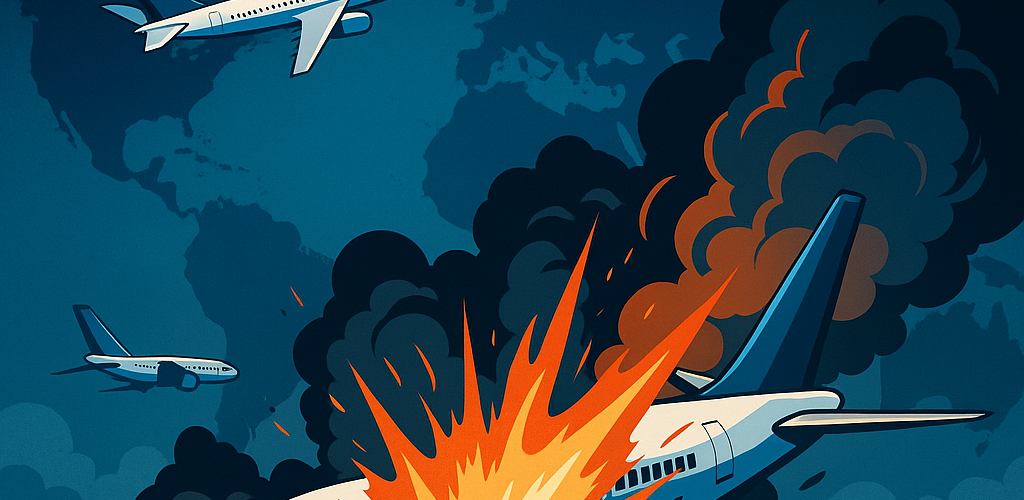Top 10 Plane Crashes That Shocked the World

Air travel offers one of the safest modes of transportation, yet some tragic accidents still haunt the aviation world. Each crash forces the industry to rethink safety, improve regulations, and strengthen technology. Some crashes, including the recent Ahmedabad disaster, remind everyone of the risks that still exist. Here are ten plane crashes that shocked the world and left a lasting impact.
1. Air India Flight 171 – Ahmedabad, June 12, 2025
On June 12, 2025, Air India Flight 171 took off from Ahmedabad, bound for London. Within minutes, the Boeing 787-8 Dreamliner issued a distress call. The pilot declared “Mayday” at 1:39 p.m. local time. Seconds later, the aircraft disappeared from radar.
The plane crashed into a residential area near Sardar Vallabhbhai Patel International Airport. A hostel building collapsed into the wreckage, trapping many people under debris. Rescue teams worked around the clock to save survivors and recover bodies. So far, they have recovered at least 30 bodies. Officials fear that more victims remain trapped.
The flight carried 242 people. Among them, 169 were Indian nationals, 53 were British citizens, seven were Portuguese, and one was Canadian. International teams from India and the United Kingdom rushed to assist with the investigation and support families.
The tragedy marked the first-ever fatal crash involving a Boeing 787 Dreamliner since its commercial launch in 2011. This event sent shockwaves through the aviation industry. Boeing faced immediate scrutiny, and its stock price dropped as investors reacted to the news. Authorities now investigate multiple factors, including mechanical failure, weather conditions, and operational procedures at the airport.
2. Tenerife Airport Disaster – March 27, 1977
The world witnessed its deadliest aviation accident at Tenerife North Airport in Spain. A KLM Boeing 747 attempted to take off while a Pan Am Boeing 747 remained on the same runway. Dense fog covered the airfield, making visibility almost impossible.
The two jumbo jets collided, killing 583 people. Investigators blamed miscommunication between pilots and air traffic controllers, unclear instructions, and rushed decisions. This disaster forced aviation authorities worldwide to revise cockpit communication protocols. Pilots and controllers now follow standard phraseology to prevent misunderstandings.
3. Air India Express Flight 812 – Mangalore, May 22, 2010
The Boeing 737-800 approached Mangalore Airport but overshot the tabletop runway. The plane plunged down a hillside and burst into flames. Out of 166 people onboard, 158 lost their lives. Only eight passengers survived.
Investigators found that pilot fatigue and poor approach stability caused the accident. The crash led to better safety measures at airports with challenging runway conditions. Authorities also introduced stricter monitoring of crew rest periods and approach protocols.
4. American Airlines Flight 191 – Chicago O’Hare, May 25, 1979
Shortly after takeoff from Chicago O’Hare International Airport, a McDonnell Douglas DC-10 lost its left engine. The separation damaged hydraulic systems and critical control surfaces. The aircraft rolled to the left and crashed, killing all 271 people on board.
Investigators traced the accident to improper maintenance procedures that weakened engine pylon mounts. The tragedy led to stricter rules for engine maintenance and inspections. The crash remains the deadliest in U.S. aviation history.
5. Japan Airlines Flight 123 – Mount Takamagahara, August 12, 1985
Shortly after leaving Tokyo, a Boeing 747SR experienced explosive decompression caused by a faulty repair on its rear pressure bulkhead. The damage led to the total loss of hydraulic systems. The crew lost control of the aircraft, which eventually crashed into Mount Takamagahara.
Out of 524 people onboard, only four survived. The investigation revealed that a previous repair failed, compromising the aircraft’s structural integrity. This tragedy led to major reforms in airline maintenance oversight and stricter repair quality checks.
6. Swissair Flight 111 – Peggy’s Cove, Canada, September 2, 1998
Swissair Flight 111 encountered an onboard fire due to faulty wiring and flammable insulation materials. The fire spread rapidly, overwhelming the crew’s efforts to save the plane. The MD-11 crashed into the Atlantic Ocean near Nova Scotia, killing all 229 passengers and crew.
The crash prompted global changes in aircraft design. Manufacturers improved wiring insulation and required the use of fire-resistant materials inside cabins to prevent similar disasters.
7. Malaysia Airlines Flight MH17 – Ukraine, July 17, 2014
While flying from Amsterdam to Kuala Lumpur, Malaysia Airlines Flight MH17 flew over Eastern Ukraine during armed conflict. A surface-to-air missile struck the Boeing 777, bringing it down instantly. All 298 passengers and crew died.
This tragedy highlighted the risks of flying over conflict zones. International aviation authorities responded by creating strict guidelines for flight routes, requiring airlines to avoid dangerous airspace during conflicts.
8. Air France Flight 447 – Atlantic Ocean, June 1, 2009
Air France Flight 447 flew from Rio de Janeiro to Paris when it encountered severe weather over the Atlantic. Ice crystals blocked the aircraft’s pitot tubes, causing incorrect airspeed readings. The pilots struggled to regain control after the plane entered a stall. The Airbus A330 crashed into the ocean, killing all 228 people onboard.
The crash exposed weaknesses in pilot training for high-altitude stalls. Authorities responded by improving training programs and upgrading airspeed sensor technology across commercial fleets.
9. Turkish Airlines Flight 981 – Paris Orly, March 3, 1974
The cargo door of a McDonnell Douglas DC-10 failed mid-flight, causing explosive decompression. The incident disabled critical flight controls and forced the plane into a steep dive. The aircraft crashed in a forest near Paris, killing all 346 people onboard.
Investigators found design flaws in the cargo door latching system. After the crash, regulators ordered manufacturers to redesign cargo doors and improve pre-flight inspections to ensure proper latching.
10. Charkhi Dadri Mid-Air Collision – November 12, 1996
A Saudi Arabian Boeing 747 collided with an Indian Airlines Boeing 737 in mid-air near Delhi. Communication errors and altitude misunderstandings led both planes onto the same flight path. The collision killed all 349 people onboard both aircraft.
This tragedy forced global aviation regulators to mandate Traffic Collision Avoidance Systems (TCAS) on all commercial aircraft. These systems allow planes to detect nearby traffic and issue automatic avoidance instructions to pilots.
The Common Lessons from These Crashes
Every tragedy brought valuable lessons that reshaped the industry. Investigators found recurring themes:
- Pilot errors often played a major role.
- Maintenance mistakes exposed weaknesses in aircraft safety.
- Poor communication between crews and air traffic controllers led to fatal misunderstandings.
- Design flaws demanded immediate engineering solutions.
- Conflict zones introduced new risks for civilian aircraft.
Aviation authorities worldwide acted quickly after each crash. They introduced new regulations, revised protocols, and invested in advanced technologies to prevent similar accidents.
Ahmedabad Crash: A Modern-Day Wake-Up Call
The Ahmedabad crash in 2025 highlighted ongoing challenges. The plane crashed into a heavily populated residential zone, killing many people on the ground. Emergency teams responded rapidly to rescue survivors trapped under debris. Leaders from India and the United Kingdom coordinated efforts to support victims’ families.
The investigation into the Boeing 787’s failure now involves multiple global agencies. Aviation experts study black box data, flight performance, and maintenance records to identify the root cause. Boeing faces new questions about its safety track record. The incident shows that even the most advanced aircraft remain vulnerable to unexpected failures.
The Future of Aviation Safety
Despite these tragedies, aviation remains safer today than ever before. Engineers design modern planes with multiple backup systems. Pilots train for complex scenarios. Air traffic controllers follow strict protocols. Still, no system offers absolute safety.
The Ahmedabad disaster reminds everyone that the aviation industry must remain vigilant. Authorities must review safety measures regularly, enforce maintenance standards, and invest in emergency response readiness. Each accident teaches new lessons, and every lesson strengthens aviation for future travelers.
Conclusion
Every crash listed here changed the aviation world. Families mourned, investigations followed, and governments enforced new regulations. Each tragedy forced the industry to confront weaknesses and implement stronger safeguards. The Ahmedabad crash adds another painful chapter to this history but also pushes the aviation world to learn, adapt, and prevent future disasters. Aviation safety remains a never-ending journey of improvement.













